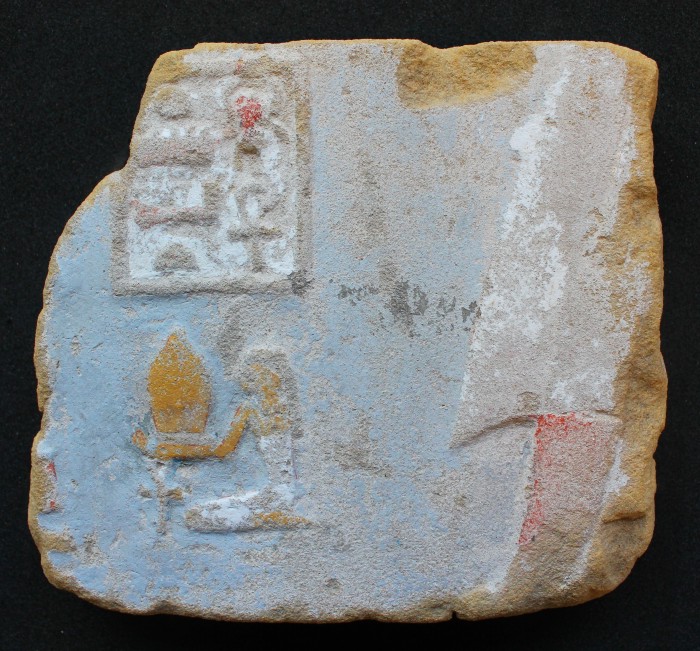W1371
W1371

Relief from the mortuary temple of Thutmose III at Kurna, on the west bank at Thebes. This measures 18cm by 15.5cm. It is made of sandstone painted with blue, white and red paint. c.1450 BC.
The square at the top reads ‘hnkt ‘nkh Mn-khpr-Re’ which means ‘Offering Life to Menkheperre’. Menkheperre Re is the name of Thutmose III and means ‘Enduring is the Form of Re’.
Ricke excavated part of the temple in 1930 (Ricke 1939). More recently, the temple was excavated from 2008 by a joint expedition of Supreme Council of Antiquities of Egypt and the Academy of Fine Arts of Seville, Spain; led by Dr. Myriam Seco Álvarez and Dr.Nur Abd el Gafar Mohamed. The web site for the excavation is here: http://thutmosisiiitempleproject.org/index.php/en/
Mortuary temples were known by the ancient Egyptians as ‘Mansions of Millions of Years. Thutmose III built other mortuary temples e.g. the Akh-menu at Karnak and the Djeser Akhet at Deir el Bahri.
The actual date of the building of the Heneket-ankh is uncertain (PM II, pp. 426–429). It is first mentioned on Hatshepsut’s Red Chapel at Karnak, where, it is listed among other structures which are dedicated to Amun (Lacau and Chevrier 1977 I, 80 and II, pl. iv. 290). The Red Chapel is dated to just after the 16th year of the co-regency (Laskowski 2006, 185). Since this is a dedication it seems likely that the temple was complete at this time. The latest date is upon an ostracon referring to three stonemasons working on the temple in the 49th regnal year of Thutmose III (Hayes 1960, 52; Wiercińska 2010, 224–225). Of course, there was alterations and rebuilding from time to time and offerings would continue to be made to the dead king in the temple during the reigns of his successors. It also seems that the bark of Amun would have rested here during the Beautiful Festival of the Valley processions (Dolińska 2007, 77–79).
The item was originally purchased as part of the Robert de Rustafjaell collection purchased at auction by Henry Wellcome at a Sotheby’s auction of 1906 probably lot 57 or 58).
References and Further Reading
Dolińska, M. 2007. ‘Temples at Deir el-Bahari in the New Kingdom’ in B. Haring and A. Klug (eds.), Ägyptologische Tempeltagung. Funktion und Gebrauch altägyptischer Tempelräume. Leiden, 4.-7. September 2002 , Wiesbaden. 71–87.
Hayes, W. 1960. ‘A Selection of Tuthmoside Ostraca from Dēr El-Bahri’, Journal of Egyptian Archaeology 46, 29–53.
Lacau, P. and Chevrier, H. 1977. Une chapelle d’Hatshepsout à Karnak. Paris.
Laskowski, P. 2006. ‘Monumental Architecture and the Royal Building Program of Thutmose III’, in E. Cline and D. O’Connor (eds.), Thutmose III: A New Biography. Ann Arbor, 183–237.
Metawi, D. 2013.’A brother for Thutmose III (Cairo Museum BN 104)’, Journal of Egyptian Archaeology 99, 101–116.
Ricke, H. 1939. Der Totentemple Thutmoses III (BABA 2,1), Cairo.
Wiercińska, J. 2010. ‘The change of dimensions of the bark of Amon in the light of recent studies on the temple of Tuthmosis III at Deir el Bahari’, in M. Dolińska and H. Beinlich (eds.), Ägyptologische Tempeltagung. Interconnections between Temples. Warschau, 22.–25. September 2008. Wiesbaden, 221–231.